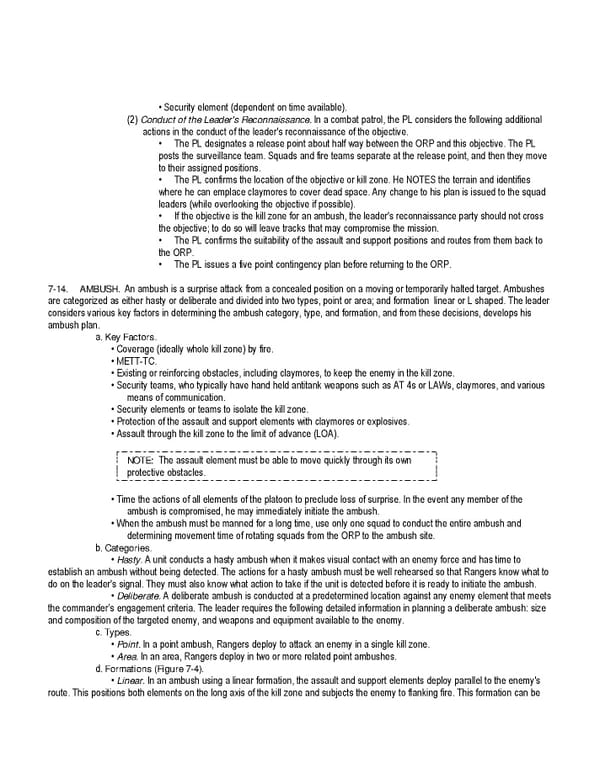• Security element (dependent on time available). (2) Conduct of the Leader's Reconnaissance. In a combat patrol, the PL considers the following additional actions in the conduct of the leader's reconnaissance of the objective. • The PL designates a release point about half way between the ORP and this objective. The PL posts the surveillance team. Squads and fire teams separate at the release point, and then they move to their assigned positions. • The PL confirms the location of the objective or kill zone. He NOTES the terrain and identifies where he can emplace claymores to cover dead space. Any change to his plan is issued to the squad leaders (while overlooking the objective if possible). • If the objective is the kill zone for an ambush, the leader's reconnaissance party should not cross the objective; to do so will leave tracks that may compromise the mission. • The PL confirms the suitability of the assault and support positions and routes from them back to the ORP. • The PL issues a five point contingency plan before returning to the ORP. 7-14. AMBUSH. An ambush is a surprise attack from a concealed position on a moving or temporarily halted target. Ambushes are categorized as either hasty or deliberate and divided into two types, point or area; and formation linear or L shaped. The leader considers various key factors in determining the ambush category, type, and formation, and from these decisions, develops his ambush plan. a. Key Factors. • Coverage (ideally whole kill zone) by fire. • METT-TC. • Existing or reinforcing obstacles, including claymores, to keep the enemy in the kill zone. • Security teams, who typically have hand held antitank weapons such as AT 4s or LAWs, claymores, and various means of communication. • Security elements or teams to isolate the kill zone. • Protection of the assault and support elements with claymores or explosives. • Assault through the kill zone to the limit of advance (LOA). NOTE: The assault element must be able to move quickly through its own protective obstacles. • Time the actions of all elements of the platoon to preclude loss of surprise. In the event any member of the ambush is compromised, he may immediately initiate the ambush. • When the ambush must be manned for a long time, use only one squad to conduct the entire ambush and determining movement time of rotating squads from the ORP to the ambush site. b. Categories. • Hasty. A unit conducts a hasty ambush when it makes visual contact with an enemy force and has time to establish an ambush without being detected. The actions for a hasty ambush must be well rehearsed so that Rangers know what to do on the leader's signal. They must also know what action to take if the unit is detected before it is ready to initiate the ambush. • Deliberate. A deliberate ambush is conducted at a predetermined location against any enemy element that meets the commander’s engagement criteria. The leader requires the following detailed information in planning a deliberate ambush: size and composition of the targeted enemy, and weapons and equipment available to the enemy. c. Types. • Point. In a point ambush, Rangers deploy to attack an enemy in a single kill zone. • Area. In an area, Rangers deploy in two or more related point ambushes. d. Formations (Figure 7-4). • Linear. In an ambush using a linear formation, the assault and support elements deploy parallel to the enemy's route. This positions both elements on the long axis of the kill zone and subjects the enemy to flanking fire. This formation can be
 Ranger Handbook Page 121 Page 123
Ranger Handbook Page 121 Page 123